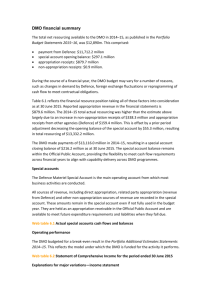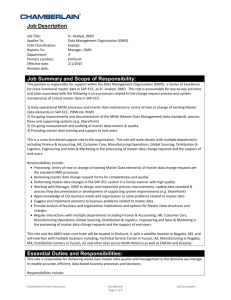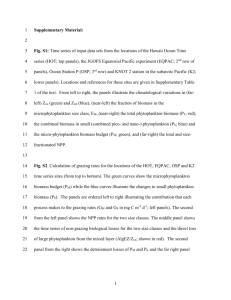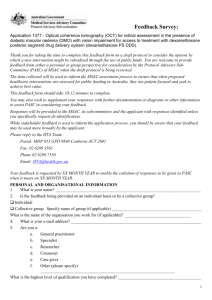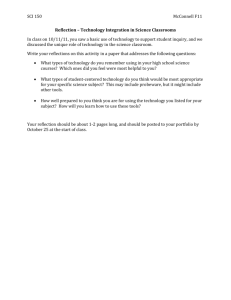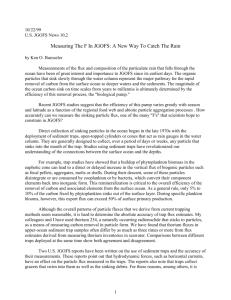PPT - US Joint Global Ocean Flux Study
advertisement
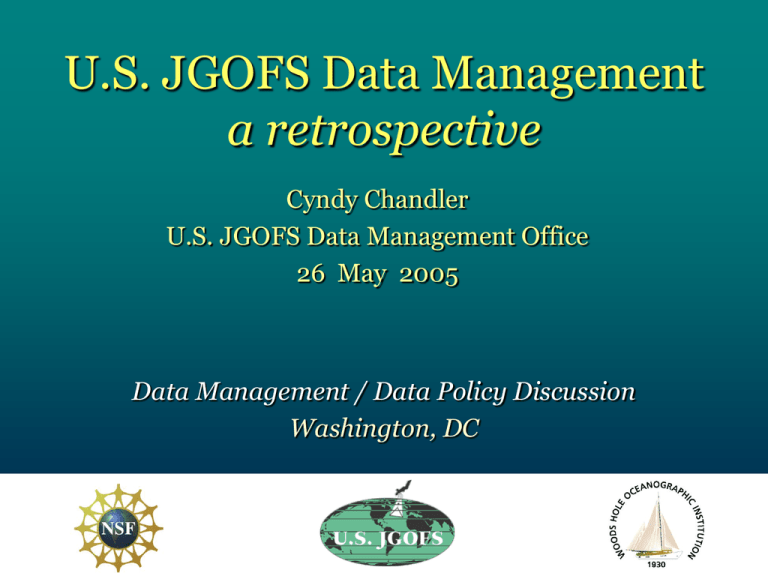
U.S. JGOFS Data Management a retrospective Cyndy Chandler U.S. JGOFS Data Management Office 26 May 2005 Data Management / Data Policy Discussion Washington, DC Topics in today’s presentation: Introduction • What is U.S. JGOFS? • What is the DMO? Lessons Learned • U.S. JGOFS data server JGOFS d-DBMS and user interface Live Access Server 26 May 2005 U.S. JGOFS DMO 2 of 45 What is U.S. JGOFS? U.S. Joint Global Ocean Flux Study part of multinational JGOFS U.S. Global Change Research Program (US GCRP), Scientific Committee on Oceanic Research (SCOR), and International Geosphere-Biosphere Programme (IGBP) long term (U.S. 1989-2005) multidisciplinary (bio, chem, PO, geology) process studies (U.S. 1989-1998), time-series, global surveys, synthesis and modeling, data management investigate ocean carbon flux 26 May 2005 U.S. JGOFS DMO 3 of 45 U.S. JGOFS Data Management Office (DMO) formed in 1988 specifically to meet needs of U.S. JGOFS assist PIs to submit their data to DMO ongoing quality control of data develop and maintain simple, reliable interface to program data provide timely, easy access to project results collaborate with other program DMO publish U.S. JGOFS data reports plan final archive of U.S. JGOFS information 26 May 2005 U.S. JGOFS DMO 4 of 45 Basic Principles of Data Management from 1988 JGOFS Working Group on Data Management scientists will generate data in a format useful for their needs oceanographic data sets are best organized in terms of metadata (temporal and geographical) data managers should avoid use of coded data values users should be able to obtain all the data they require from one source and in a consistent format data interchange formats should be designed for the convenience of scientific users 26 May 2005 U.S. JGOFS DMO 5 of 45 Additional Guidelines metadata is critical and therefore mandatory data managers should maintain awareness of emerging standards and strive for compliance whatever interface is used to provide access to the data, it’s still important to provide subset and download capability data management systems must be dynamic - balancing tension between existing and new technologies 26 May 2005 U.S. JGOFS DMO 6 of 45 Basic Components of a Data Management System first four components are active throughout the program data acquisition • from variety of sources quality assurance data publication synthesis and modeling archive 26 May 2005 U.S. JGOFS DMO 7 of 45 from the American Heritage Dictionary of the English Language lesson defined . . . 1 : a passage from sacred writings read in a service of worship 2 a : a piece of instruction b : a reading or exercise to be studied by a pupil c : a division of a course of instruction 3 a : something learned by study or experience b : an instructive example 4 : an edifying example or experience 5 : a reprimand 26 May 2005 Lessons Learned . . . U.S. JGOFS DMO 8 of 45 The first lesson learned . . . is a meta lesson . . . All the lessons learned take on enhanced meaning when applied to science programs of increasing size and complexity. Lessons Learned . . . 26 May 2005 U.S. JGOFS DMO 9 of 45 Lessons Learned . . . technology is good; people are more important diverse range of expertise and personalities designers, programmers, data managers someone with authority to set overall vision qualified staff to make effective use of technology guidance from advisory committee which includes active investigators 26 May 2005 U.S. JGOFS DMO 10 of 45 U.S. JGOFS DMO personnel David Glover (director) Cyndy Chandler (manager) Previous staff members • • • • Christine Hammond (manager) George Heimerdinger (data specialist) David Schneider (data specialist) Jeff Dusenberry (data specialist) 26 May 2005 U.S. JGOFS DMO 11 of 45 Lessons Learned . . . develop a data policy, publicize and follow it guidance from steering committee consent from participating investigators reiterate at conferences and workshops encourage compliance agree on method of enforcement (used as last resort) 26 May 2005 U.S. JGOFS DMO 12 of 45 Lessons Learned . . . establish protocols at program start with mechanism for adaptation when necessary sampling methodologies naming conventions parameter dictionary, controlled vocabulary XML schema, thesauri, ontologies units of measurement 26 May 2005 U.S. JGOFS DMO 13 of 45 Lessons Learned . . . facilitate contribution of data to collection compile an inventory of expected results publish and maintain the inventory remind investigators of opportunities to contribute data and results to the growing inventory review procedure at conferences and workshops accept all formats of data work with investigators to complete metadata records 26 May 2005 U.S. JGOFS DMO 14 of 45 JGOFS distributed database management system U.S. JGOFS DMO accepted any format data from the field study investigators and used methods to locate and translate the data objects 26 May 2005 U.S. JGOFS DMO 15 of 45 Lessons Learned . . . metadata is of critical importance accurate, complete, available with data monitor emerging standards define minimal metadata requirements standards-compliant solutions where possible complete metadata record enables reuse of data metadata assembly is time consuming, but is the key to enabling secondary (reuse) of data 26 May 2005 U.S. JGOFS DMO 16 of 45 metadata 26 May 2005 U.S. JGOFS DMO 17 of 45 Lessons Learned . . . quality assurance is an ongoing process intense QA process during initial acquisition and ingestion into data system problems discovered as data are utilized by others ◊ insufficient or inaccurate metadata process of data product synthesis becomes a valuable diagnostic tool for improving data quality 26 May 2005 U.S. JGOFS DMO 18 of 45 Lessons Learned . . . begin synthesis early do not wait until all the data has been collected synthesized products greatly enhance the growing collection of data 26 May 2005 U.S. JGOFS DMO 19 of 45 Lessons Learned . . . provide timely, easy access to project results develop and maintain simple, reliable interface to data collection single interface to entire data collection balance tension between new innovative technologies and existing stable implementations if an interface is broken, it doesn’t matter how great the original concept was skip data system tech details 26 May 2005 U.S. JGOFS DMO 20 of 45 U.S. JGOFS Data Server JGOFS distributed database management system (d-DBMS) used for field data Live Access Server (LAS) used for gridded, synthesis and model results 26 May 2005 U.S. JGOFS DMO 21 of 45 26 May 2005 U.S. JGOFS data server web interface to data catalog U.S. JGOFS DMO 22 of 45 JGOFS Distributed Database Management System (d-DBMS) distributed, object-oriented system originally developed by Glenn Flierl, James Bishop, Satish Paranjpe, David Glover supports multidisciplinary, multiinstitutional data acquisition project multiple data storage formats and locations data interpreted by ‘methods’ 26 May 2005 U.S. JGOFS DMO 23 of 45 Data Listing select dataset select variable (columns) select range (rows) view metadata 26 May 2005 U.S. JGOFS DMO 24 of 45 subset, plot, download data 26 May 2005 U.S. JGOFS DMO 25 of 45 Live Access Server Interface provides access to synthesis and model results 26 May 2005 U.S. JGOFS DMO 26 of 45 Live Access Server ~ LAS LAS Development Team (original) Steve Hankin Jon Callahan Joe Sirott located at UW JISAO/NOAA-PMEL University of Washington’s Joint Institute for the Study of the Atmosphere and Ocean and NOAA Pacific Marine Environmental Laboratory 26 May 2005 U.S. JGOFS DMO 27 of 45 Live Access Server Interface configurable Web server data and metadata interface provides access to geo-referenced scientific data presents distributed data sets as a unified virtual data base (DODS/OPeNDAP) uses Ferret as the default visualization application visualize data with on-the-fly graphics request custom subsets of variables in a variety of file formats access background reference material (metadata) compare variables from distributed sources 26 May 2005 U.S. JGOFS DMO 28 of 45 LAS enables a data server to … unify access to multiple types of data in a single interface create thematic data collections from distributed data sources offer derived products on the fly offer variety of visualization styles • customized for the data 26 May 2005 U.S. JGOFS DMO 29 of 45 U.S. JGOFS LAS MySQL database of netCDF and JGOFS format data objects interface to project data and metadata data sub-selection (selections, projections) multi-variable support gridded vs. in-situ data differencing multiple views • (property-property, depth horizon, cruise tracks, overplots) multiple products (ps, gif, text, NetCDF) 26 May 2005 U.S. JGOFS DMO 30 of 45 LAS v6 select dataset and variables 26 May 2005 U.S. JGOFS DMO 31 of 45 LAS v6 constraints LAS constraints select dataset select variable set constraints select view (XYZT) select output type selections: lat/lon time depth range 26 May 2005 U.S. JGOFS DMO 32 of 45 select dataset select variable set constraints output 26 May 2005 LAS output U.S. JGOFS DMO 33 of 45 Property Depth LAS v6 PropertyDepth Arabian Sea Nitrate from merged product generated by DMO from in situ Niskin bottle data 26 May 2005 U.S. JGOFS DMO 34 of 45 Comparison Overlay Plot 26 May 2005 U.S. JGOFS DMO 35 of 45 overlay plot chlorophyll (May) shaded SeaWiFS data contributed by: Yoder and Kennelly surface nitrate (April) contours Nutrient Climatologies contributed by: Ray Najjar 26 May 2005 U.S. JGOFS DMO 36 of 45 U.S. JGOFS Data System Summary supports a variety of data formats OPeNDAP used to access data collection coupled metadata and data supports data subselection offers variety of products for download 26 May 2005 U.S. JGOFS DMO 37 of 45 Lessons Learned . . . encourage data managers to collaborate other data managers within program JGOFS DMTT data managers from other programs GLOBEC, LTER program investigators and participants attend conferences and workshops offer data system tutorials 26 May 2005 U.S. JGOFS DMO 38 of 45 Lessons Learned . . . publish data reports archive data in one place easy access to project results most complete and accurate form of database 26 May 2005 U.S. JGOFS DMO 39 of 45 data reports published on CD-ROM 26 May 2005 U.S. JGOFS DMO 40 of 45 Lessons Learned . . . plan early for final archive of program results digital records don’t forget the boxes of stuff ! 26 May 2005 U.S. JGOFS DMO 41 of 45 Lessons Learned . . . develop a data policy, publicize and follow it establish protocols at program start with mechanism for adaptation when necessary facilitate contribution of data to collection metadata is of critical importance accurate, complete, available with data quality assurance is an ongoing process begin synthesis early 26 May 2005 U.S. JGOFS DMO 42 of 45 Lessons Learned . . . provide timely, easy access to project results develop and maintain simple, reliable interface to data collection encourage data managers to collaborate publish data reports plan early for final archive of program results 26 May 2005 U.S. JGOFS DMO 43 of 45 Challenges functioning amid the chaos maintaining a healthy data management system amid the chaos of rapidly changing information technology distinguishing between enabling and disruptive technologies data and results – what to preserve? raw and processed data, synthesized products, model code, inputs, results increasing volume and diversity long-term preservation of data 26 May 2005 U.S. JGOFS DMO 44 of 45 U.S. JGOFS web site http://usjgofs.whoi.edu 26 May 200526 May 2005 U.S. JGOFS DMO 45 of 45

